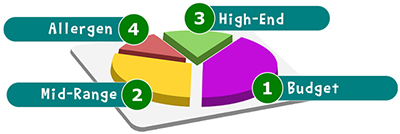This is Part 1 from 125 Building Blocks for Your Bakery Business
In this chapter, you will turn your most critical eye at the bakery marketplace and examine your competitors and greatest sources of inspiration. You will also study your potential customers.
Identify Your Avatars
![]()
In business, the term for your target customer, as in the kind of person who represents the heart of your demographic, is called an avatar. In some cases, you may have more than one avatar. Here are four avatars that bakeries tend to encounter:
- The Working Mom
- Brides & Grooms
- The Single Man
- The Corporate Receptionist
Identify Your Avatars’ Wants & Needs
It’s important to dive deeper than just the basic facts about your avatars. How do they spend their time? Their money? What motivates them? What matters to them? Who do they trust most?
The Working Mom’s Avatar
When it comes to the purchasing of cakes and desserts, females are the overwhelming majority of shoppers. In many cases, those females are also working mothers. Every year, the working mother will consider purchasing a birthday cake for every one of her children and possibly for her spouse and other relatives as well. That adds up to a lot of potential sales for you. So how can you secure her ongoing business?
How to Secure the Working Mom’s Business
- Keep track of her family member’s birthdates by setting up your own calendar reminders.
- Contact her one month before each birthday to ask if she wants to place an order again this year.
- Keep track of her preferences. Set up a spreadsheet or order history file.
- Provide a punch card, buy 5 cakes, get the 6th for free.
The Bride & Groom Avatar
If you make wedding cakes, you will encounter all different kinds of couples seeking to make their largest ever dessert purchase for the biggest event of their life. For brides and grooms, this purchase is not just a transaction; it’s a milestone. You are not just selling cake; you are selling an experience they will always remember. That’s why wedding cakes requires far more work and customer interaction than birthday cakes. Birthdays come around every year. A person’s wedding day only comes once in a lifetime.
How to Secure the Bride & Groom’s Business
- Develop an efficient system for quoting wedding cake requests.
- Offer free cake tastings and design consultations.
- Be flexible and willing to work within various budgets.
- Learn when to say no. Not all budgets, designs, or clients are worth taking on.
The Single Man Avatar
For retail bakeries, the single man is a common type of walk-in, impulse shopper. If you treat him right, you can convert him from a one-time-only visitor into a regular paying customer, especially for his morning coffee and pastry.
How to Secure the Single Man’s Business
- Learn his name. When he stops into your shop, call him by name.
- Get to know his habits and preferences so you can anticipate his orders.
- Offer him a free item every once in a while, perhaps a sample of something he’s never tried.
The Corporate Receptionist Avatar
The corporate receptionist typically does the purchasing for social events organized in their office such as staff luncheons, staff birthdays, and holiday parties. Since receptionists pay with the company’s dime, they will be less concerned with cost. However, they might have a budget assigned or be required to run their purchasing decisions past a supervisor.
How to Secure the Corporate Receptionist’s Business
- Learn what you can about the company and the supervisor in charge.
- Does the receptionist or supervisor have a flavor preference? A food allergy? Keep track of these details.
- When the receptionist places a large order, throw in a free special treat just for them. This will incentivize them to select you as a vendor the next time they need to place another large order.
Analyze the Broader Market
A great way to collect ideas for your bakery is to check out what other bakeries are doing in other parts of the world. With the ease of the Internet, you can do this kind of research from home.
Always keep tabs on your peer group. Always examine how their product lines are evolving. Try not to think of them as the competition or the enemy but rather as fellow students of business who are being graded on the same curve.
Analyze Your Peer Group
For retail shops or cottage bakeries, your peer group consists of other local bakeries. These businesses will have a major impact on your sales and customer flow. For this reason, it is imperative to analyze them. Stop by their establishments. Sample their products. Play the part of their customer.
Exercise for Retail Bakeries
- Visit the most popular local bakeries in your area.
- What do they sell?
- In what ways do they service their customers?
Exercise for Wedding Cake Vendors
- Email or call the wedding cake vendors in your area.
- Pose as a customer.
- Ask for a cake quote.
- Compare and contrast their different styles of responding.
Exercise for Wholesale Bakery Products
- Visit the stores where products in your area of interest are sold (supermarkets, Costco, Walmart, etc.)
- Note the product size, weight, price, and quality of the baked goods. This will give you the most accurate indication of what the corporate buyers are looking for.
- Examine the brands whose products appear the most. Research those bakeries online.
Map the Market

Once you have identified your peer group, map them out geographically.
Retail bakeries benefit from being located in a place with plenty of foot traffic, such as in a downtown commercial area, a shopping mall, or shopping complex. Sweets are often an impulse buy so the more pedestrians you have passing by your window, the better. If you rely heavily on foot traffic, try not to position yourself within close walking distance of another bakery.
Wholesale bakeries are better off finding locations that are off the beaten path, since they don’t rely on foot traffic at all. Delivery trucks will need a loading dock and space to come and go. For this reason, industrial parks and warehouse facilities make more sense. Seek to be centrally located within the area you aim to service. For instance, if you have one large city and two large towns nearby, seek to position yourself somewhere in between them. That will cut down on your shipping costs. For wholesale bakeries aiming for national distribution, the ideal location is in the center of the country.
Map the Categories

Your next level of search should involve identifying the type of bakeries in your area. Let’s take retail bakeries as an example. Not all retail bakeries are the same. You will find that most retail bakeries fall into one of four categories:
1. Budget Bakery
– shortening-based products
– cake-mix-based products
– DecoPac designs
2. Mid-Range Bakery
– falls between categories 1 & 3
3. High End Bakery
– all natural ingredients
– scratch baking
– butter-based products
– custom cake designs
4. Allergen Friendly Bakery
– example: gluten free
– example: dairy free
– example: nut free
Map the Saturation

Once you have mapped all the local bakeries by category, look for areas that are saturated, in other words that already have one or more existing bakeries per category, in your area.
Ideally, aim to position your business to service the part of the market for which there is the highest demand and the least competition in terms of both saturation and category.
Map the Demographics

As you map your competition, examine the corresponding demographics of the resident population. The local population’s level of income and cultural preferences dictates their buying habits. Their buying habits can make or break your business. For instance, if you make kosher pastries but there is no kosher community in your desired area, you might look for another angle or search for an area that contains more of your target population.
Or if you are looking in an area where the local demographic is chiefly high income and you discover that there are a lot of low- to mid-range bakeries there, you would be wise to fill the void by specializing in high-end baking. Likewise, if you discover that there are a lot of high-end or mid-range bakeries in a low-income area, then you would be wise to fill the void by selling products that cater to a budget-conscious consumer.
Exercise for Retail Bakeries
- Go to Google Maps.
- Enter your address.
- Do a “nearby” search using the word bakery.
- Check to confirm which locations are still in business.
- Determine which category each bakery falls into.
- If you see clusters of the same category in the same area, avoid pursuing that particular bakery concept in that particular area.
- Expand your search to include surrounding towns.
- Look for areas that are densely populated with no existing bakery.
- Research the demographic of each area. What is the average income of its residents? Is it high, medium, or low?
- Look for the pockets where there is a void.
- If necessary, modify your concept to service that market.
Mimic Success
There is an art to doing business. Like any art form, business people inspire and influence one another. By mimicking the success of others, we imitate what has already been proven to work. I’m not talking about cloning someone else’s ideas. I’m talking about appropriating strategies that have an existing track record of achievement.
Besides examining the success stories within your field, you can also learn a lot from looking outside of the dessert industry for influence. For instance, you might examine how a successful pizza parlor runs their business. From their marketing campaigns to their unique interior decor to their customer service strategies, you may discover all kinds of genius ideas. Mimic those ideas.
Exercise for Retail Bakeries
- What do the successful bakeries seem to be doing well?
- What does the outside of their shop look like in terms of color, style, architecture, & signage?
- What does the inside of their shop look like? How is it decorated?
- How are their products displayed?
- Do they have a seating area?
- Do they serve beverages?
- How do they use their social media?
Undercut

Undercutting is the term used for when a manufacturer sells the same product as their competition, only for a better value. In the wholesale bakery manufacturing industry, undercutting is part of the game. A successful line of existing products indicates that there is a demand for said product. Where there is demand, there is business to be had. As a wholesale manufacturer, it is not considered unethical to jockey for some or all of that business. It is considered aggressive but fair play.
If you do decide to try to undercut a competing business, just make sure you are hitting your desired profit margin when you do so. It’s not worth undercutting a peer only to end up breaking even or losing money in the manufacturing process.
If you wouldn’t dream of undercutting a peer, be aware that others do and others will, especially if you offer a unique product.
Innovate

The opposite strategy of mimicking or undercutting is to be different. Innovate. Blaze a new trail. Keep in mind that if you are especially innovative, your fellow peers may copy your work. For that reason, never allow yourself to get too comfortable or too reliant upon a single product or product line. Keep growing. Keep inventing.
By inventing new ideas, you could create a whole new craving, which leads to an unexpected dependency on your products that people never previously had. A good example is the cronut, which took America by storm. The cronut is an example of a hybrid food since it combines two ideas: the croissant and the donut. Hybrid desserts are especially trendy because they accomplish two things: they are both familiar and different. The cronut borrows from concepts that are already exceedingly popular to create something brand new.
Exercise: Discover the Path to Innovation
- Embrace Accidents: Examine your mistakes. Sometimes mistakes lead to fabulous accidental discoveries.
- Experiment: Study cookbooks, but also try baking without recipes. Or try combining ideas from different recipes. Mix, match, & mash up as many different ideas as you can.
- Borrow Concepts: Explore other categories of food to find inspiration. Ice cream, candy, alcoholic cocktails, or other beverages provide a wealth of ideas that can be reconfigured into dessert flavors. Study these kinds of menus. Flip through these kinds of books. Squint your mind. See what happens when you invite the ideas to blur together.
This is the end of Part 1 from 125 Building Blocks for Your Bakery Business.
Return to the Table of Contents or continue to Part 2 – Bakery Selling Options

Related Material





